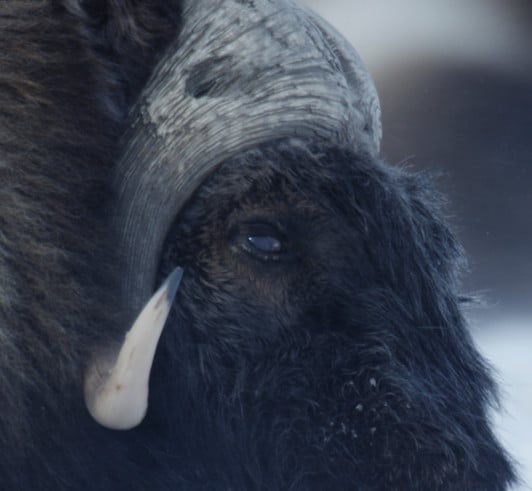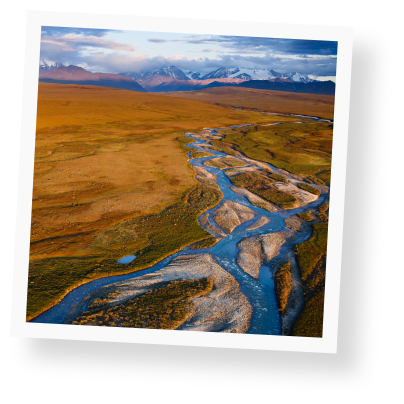By Florian Schulz, National Geographic photographer and Cinematographer for “The Arctic: Our Last Great Wilderness” (watch IMAX film trailer). This essay is an excerpt from Florian’s book Journey to the Arctic, written by Florian and Emil Herrera-Schulz.
It is still dark when I leave my tent and the weather outside is well below freezing, but I am eager to find the muskoxen before the sun breaks over the horizon. I have spent many hours over the past few days watching these intriguing animals as they wait out the winter. With long fur coats and heavy, curled horns, they look prehistoric, like creatures from a fairy tale.
When the days get shorter and the arctic winter approaches, birds and caribou migrate south, and polar bears venture back out onto the sea ice. The tundra is blanketed in snow, and for many miles no life can be seen. Few animals are adapted to live in the Arctic year-round, but the muskox is one of them. With its long guard hairs and woolly undercoat that is eight times warmer than the highest quality sheep’s wool, a muskox can withstand even the harshest arctic conditions.
I am wrapped in several layers of polar bear fleece and outer garments, but at 20 degrees below zero, my face is beginning to feel numb and my hands are stiff and struggling to manage my camera. The stars are fading in the predawn light as I make my way to the place where I had watched the muskox herd the day before. Resting my telephoto lens on the frozen rocks in front of me, I had watched as a big muskox bull gathered his herd into a tight group, eyeing me curiously as I lay on my stomach on the packed snow. I could smell the bulls’ musky odor, which gives these creatures their name. I discovered that if I stayed close to the ground, the muskoxen didn’t seem to mind my presence.
With their sturdy bodies and weighty horns, muskoxen aren’t built for speed, so I think they must not have gone far. I also know that they have to conserve their energy in the winter. Even when threatened, muskoxen don’t run from danger, but form a circle around their calves, their horns facing out for protection.
Now, as I return to my post, I am surprised to see only blank, white tundra where the muskox herd stood. I search the surrounding hilltops with my binoculars, but can’t see a single animal. As the northeast horizon is beginning to glow orange, I worry that I won’t find the herd by the time the sun comes up.
To get a better view of the surrounding landscape, I climb toward the top of the nearest hill. When I reach the ridge, I discover the herd standing on the steep slope below me. The wind is blasting this side of the hill at 40 miles per hour, but the musk oxen are intent on their task.
I watch as they kick with their large hooves, sending clouds of snow blowing into the wind. Now I understand why they moved to the exposed side of the mountain. Here, the wind blows the snow away from the ground, leaving only a few inches covering the lichen below. It is a marvel that these large creatures can live through the long arctic winter, feeding only on bits of frozen lichen.
As the muskoxen find their breakfast below the snow, I take out my wide-angle lens and frame the whole herd. The sunrise frames the clear sky, painting the surrounding hills golden as I begin to photograph. This scene is exactly what I had hoped to find when I left the warmth of my sleeping bag before dawn. During late winter in the Arctic, most of the daylight looks like dawn or dusk, the sun hovering over the horizon for only a few hours before sinking, plunging the icy landscape into another long arctic night.
The next day, I plan to photograph the muskoxen as the sun is setting. This time, I have no trouble finding the herd. They have returned from the steep side of the mountain, somehow satisfied by their meager lichen meal the day before. The sky is clear, but the wind has picked up overnight, blowing snow through the air. As I walk toward the herd, they look like shadows behind dense fog. The thick layer of snow blowing around their feet makes it seem like they are floating on air.
Ice crystals whip my face, stinging like grains of sand. Even in the bitter cold, I am excited by the way the wind is transforming the landscape. In my years of traveling the Arctic, I have seen weather like this many times. Through my photographs, I always try to show the real arctic world--a place that is always fascinating and beautiful, but also harsh and unpredictable.
The muskoxen don’t seem to notice the wind at all. They must withstand these conditions throughout the winter. As I photograph a group of bulls, I can’t help wishing for a muskox’s warm coat to protect me through the storm.
This essay is an excerpt from Florian’s book Journey to the Arctic, written by Florian and Emil Herrera-Schulz.




